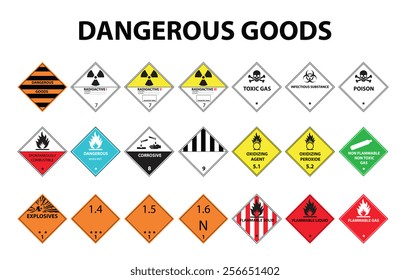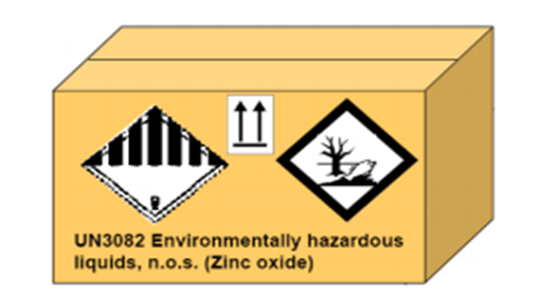Class 9 Miscellaneous dangerous goods ie. And b a firepoint that is less than the boiling point.
Https Www Asean Org Wp Content Uploads Images 2015 September Transport Facilitation Batch 3 Dangerous Goods Handling All Modes Chapter 204 2 Asean 20disclaimer Pdf
Environmentally hazardous substances which are not covered by other classes.

Class 9 dangerous goods storage requirements. Hazardous chemical means a substance mixture or article that satisfies the criteria for a hazard class in the GHS as defined in the WHS Regulation. The image at 522211 clearly indicates the 100 mm minimum applies to each diagonal side of the label. Hazardous chemicals that are subject to the WHS Regulation covers dangerous goods excluding explosives Class 1 radioactive materials Class 7 infectious substances Division 61 and certain miscellaneous dangerous goods Class 9.
Dangerous Goods Safety Storage and Handling of Non-explosive Regulations 2007 guide Page 9 of 80 Type of goods Description Dangerous goods label Reference for classification Class 5 Oxidising substances organic peroxides ADG Code Division 51 Oxidising substances Division 52 Organic peroxides Division 61 Toxic substances ADG Code. This Standard sets out requirements and recommendations for the safe storage and handling of dangerous goods and articles of Class 9 ie. 10052017 CLASS 9 Label Fig.
General Requirements for the storage of all Dangerous Goods The area where dangerous goods are stored should be. 3 Copies 12m drop test 25 kg 552 lb of batteries or 125 CellsKits 4. 3 Color Copies UPSDG Contract requiredShippers Dec.
Bitumen dry-ice expandable polystyrene beads Mixed Class A vehicle transporting more than one Class of dangerous goods ie. 5 Lithium Battery Safety Document See Section 90 Full Shippers Declaration for Dangerous Goods FedExDG Contract required Shippers Dec. The effect of these reforms is to place dangerous goods within a risk management framework consistent with all other types of hazards found within workplaces.
This code of practice provides advice on applying this risk management framework to dangerous goods. Limited quantities of miscellaneous hazardous materials in Packing Groups II and III are excepted from labeling requirements unless the material is offered for transportation or transported by aircraft and are excepted from the specification packaging requirements of this subchapter when packaged in combination packagings according to this. 07022021 Class 9 includes inter alia.
Class 9 Miscellaneous dangerous goods and articles GOODS TOO DANGEROUS TO BE TRANSPORTED Goods listed in Appendix 5 of the ADG Code and goods determined to be so by an Authority ADG Code COMBUSTIBLE LIQUID. In the 2017 edition of the ADG Code it was made a requirement that transportation of lithium batteries must exclusively use the new Class 9a label figure 2 below from 31 December 2018. B Limited quantities of Class 9 materials.
2 CARGO Label Fig. Elevated temperature substances ie. 25032019 The IMO Dangerous Goods Code at 522211 mandates the label to be a minimum of 100 mm on a side.
Any liquid other than a flammable liquid that has a flashpoint and that has a fire point less than its boiling point C1 Combustible liquid. It is important that containers used for hazardous substances do not usually contain food or beverages or could be mistaken as such. Dangerous Goods Act 1975.
For simplicity we will classify them as small common consumer batteries that youll find in mobile phones laptops flashlight etc which have a maximum cell power of 20 Wh or 1g of Lithium or battery power of 100 Wh or 2g. The process of certification can be an arduous one and requires the involvement of multiple government agencies as well as local fire departments and other entities. Well ventilated and well lit.
Mixed loads which falls within the scope of placard quantities is required to have displayed on the front and rear of the vehicle a mixed Class diamond. Dangerous Goods General Regulation 1999 will be repealed. Substances that are transported or offered for transport at temperatures equal to or exceeding 100C in a liquid state or at temperatures equal or exceeding 240C in a solid state.
Packaged hazardous chemicals means Schedule 11 hazardous chemicals. For these safety reasons they are classified as dangerous goods and special transport regulations apply. All Lithium batteries LiBa are classified as dangerous goods.
17042018 A warehouse must be certified to store hazmat products and must obtain certification specific to each class of chemical that it wishes to store. Separated from ignition sources. Capacity means the internal volume expressed in litres of a container at 15oC.
Dangerous Goods Storage and Handling Regulations 2000 SR. 18032020 They must be made of material suitable for safely containing the hazardous substances at the temperatures they will be used and for as long as the substances will be contained. Lithium batteries are the only Class 9 item assigned to UN Packing Group II.
1272000 4 C1 combustible liquid means liquid dangerous goods that have a a flashpoint that is higher than 60C but no higher than 150C. Miscellaneous dangerous goods and articles as classified by the UN Recommendations on the Transport of Dangerous Goods Model Regulations and listed in the Australian Dangerous Goods Code ADG CodeNZS 5433.

Dangerous Goods Labels Images Stock Photos Vectors Shutterstock

Dangerous Goods Chemical Systems Australia Pty Ltd Compatibility Chart Chemical Substance Fire Extinguisher Label Text Png Pngegg

Dangerous Goods Regulations Cat 9

Dangerous Goods Regulations Cat 9

Transport Of Dangerous Goods In Depth Croner I

Class 9 Dangerous Goods Dg Transport Nsw

Class 9 Dangerous Goods Miscellaneous Dangerous Goods

The 9 Classes Of Dangerous Goods 8 By Shippr Medium

Import From China Hazardous Goods Customs Regulations Process Packing Required Documents Key Points Bestforworld Logistics Co Ltd Bestforworld Logistics Co Ltd

0 comments:
Post a Comment